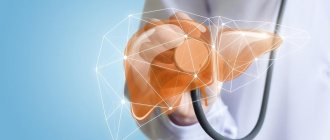According to statistics, diseases of the gastrointestinal tract occupy a leading position in the list of reasons for visiting medical institutions. The most informative diagnostic method is endoscopic examination (gastroscopy). But many note that this method is quite unpleasant, causing discomfort and a gag reflex. It is for this reason that people increasingly prefer ultrasound examination of the stomach. This procedure allows us to identify pathological processes in the main digestive organ.
Who is prescribed ultrasound of the stomach?
An ultrasound examination of the organ is recommended if, for some reason, the patient categorically refuses gastroscopy or has contraindications to it. A gastroenterologist may refer for diagnostic testing in the following cases:
- If you experience pain in the stomach;
- If there are complaints of heaviness, bloating or increased gas formation;
- If the patient complains of regular heartburn, belching;
- During episodes of causeless nausea or vomiting, diarrhea or constipation;
- If you have an unpleasant taste in your mouth or bad breath that is not related to dental problems.
In addition to these symptoms, ultrasound may also be recommended for already diagnosed pathological processes, for example, to monitor the dynamics of treatment. Examination of the digestive organ is common for diseases such as:
- Gastritis of various etiologies;
- Stomach ulcer;
- Pancreatitis;
- Reflux disease;
- Suspicion of a malignant neoplasm.
Such a study is carried out even for young children - for example, in cases of unreasonably increased capriciousness of the child, appetite disturbances, or gushing vomiting in an infant.
Advantages and disadvantages of ultrasound of the stomach
When compared with other methods of diagnosing the stomach, there are several clear advantages of ultrasound examination:
- The procedure is very quick; as a rule, the examination takes 20 minutes;
- The examination takes place without pain or discomfort;
- Serious pathological processes can be identified.
One of the disadvantages is the lack of information content - the study does not always provide comprehensive information about the condition of the stomach.
Is preparation necessary for the procedure?
As is the case with other methods of diagnosing the stomach, before an ultrasound of the abdominal cavity, it is necessary to foresee some nuances in advance.
How to prepare for an ultrasound of the stomach:
- 2 days before the ultrasound examination, it is recommended to start following a special diet. Avoid eating legumes, cabbage, dairy products, rye bread and fresh vegetables. Drinking caffeine-containing and alcoholic beverages is also contraindicated. It is advisable to avoid drinking store-bought packaged juices and kvass. All kinds of carbonated drinks are also prohibited.
- It is not advisable to eat food later than 7-8 pm. By the way, in everyday life you should also adhere to this rule. Or try to eat 3-4 hours before bedtime.
- On the day of the ultrasound of the stomach and esophagus, it is forbidden to eat or smoke. However, if you suffer from severe hunger pains, it is recommended to drink a cup of tea and eat a cracker early in the morning.
- If the examination is carried out on an infant, it is not allowed to feed the baby several hours before the examination. In this case, it is not at all necessary to carry out the diagnosis on an empty stomach. However, you should take some formula or diluted apple juice with you to give to your child later.
- On the day of the procedure (or the day before), you must have a bowel movement.
- To prepare for an ultrasound of the stomach, it is sometimes recommended to use adsorbents (for example, Lactofiltrum) or activated carbon (black or white). Sometimes Mezim or Festal may be prescribed - medications that stimulate the digestive tract.
Following these rules will help improve diagnostic accuracy.
The classic version of ultrasound of the stomach and intestines has no contraindications, so it is recommended even for small children and women during pregnancy.
However, there is also endoscopic ultrasound, during which part of the apparatus is inserted into the body. This type of ultrasound examination has a number of contraindications.
It is prohibited to perform endosonography if:
- the presence of mechanical injuries and burns localized in the digestive tract;
- stenosis (so-called narrowing of the esophagus). This pathological process is caused by tumor changes;
- poor blood clotting;
- acute and chronic processes in the oral cavity, as well as the pharynx;
- aortic aneurysm.
It is also not recommended to perform an ultrasound examination of the stomach in cases of damage to the central nervous system and severe asthma.
It must be said that the endoscopic version of abdominal ultrasound is performed if non-invasive diagnostic methods do not make it possible to understand the complete picture of the condition and functioning of the gastrointestinal tract. All procedures have both their advantages and disadvantages. Therefore, several diagnostic tools should be used.
How to properly prepare for research
If you are to undergo an ultrasound examination of the digestive organ, begin thorough preparation 3 days in advance. Let's look at the most important points.
The patient should avoid all foods that can cause flatulence, gas, or bloating. These include absolutely all fresh fruits, legumes, brown bread, coffee, flour, and dairy products. It is recommended to eat dietary dishes, for example, steamed cereals, dietary boiled meat, and low-fat fermented milk products are allowed in small quantities.
The night before the test, you should have dinner no later than 8 pm.
After waking up, you should not eat or drink. If an ultrasound examination of the stomach is scheduled for the evening, small amounts of sweet tea are allowed in the morning.
If you are prone to gas formation and bloating, this should be prevented with the help of medications. You should not smoke at least 5 hours before the ultrasound.
Features of intestinal ultrasound for children
Preliminary adherence to therapeutic nutrition is necessary in order to properly prepare for diagnosis. Without preventive measures, the results of the study will be inaccurate, the picture of the organs will be blurry. A special diet will help relieve increased gas formation. The patient begins to consume the following products three days before the scheduled procedure:
- Porridge on the water;
- Soft-boiled eggs (one per day);
- Skim cheese;
- Low-fat varieties of beef, poultry, fish, boiled, baked or steamed.
What foods are prohibited in a person’s diet before an ultrasound examination:
- Peas and legumes;
- Milk products;
- Fresh vegetables and fruits;
- Brown bread, baked goods, pastries;
- Pickles, pickled vegetables;
- Carbonated drinks;
- Alcohol, coffee, tea;
- Juices.
The doctor prescribes the patient to take medications in addition to a special diet. Preparing the body consists of using the following drugs:
- To eliminate gases.
- Laxative for bowel cleansing. Prolonged constipation can be relieved with an enema.
- Sorbents (activated carbon, lactofiltrum).
- Enzyme medications for disorders of the gastrointestinal tract.
To thoroughly prepare for the procedure, a person observes a number of conditions on the day of the ultrasound:
- You should not smoke, eat sweets or chewing gum (digestive juice is stimulated and digestion is activated).
- Refrain from brushing your teeth to prevent the toothpaste from entering your body.
- Warn the doctor who sent the patient for an ultrasound about chronic diseases and medications.
- 15 minutes before the examination, drink at least a liter of clean water to straighten the stomach. Water allows you to informatively interpret what you see on the monitor, as it is the best conductor of ultrasound.
- In some cases, the doctor sends the patient to the toilet. After a while, a second ultrasound may be performed to determine the rate of gastric emptying and gastrointestinal motility.
- Some patients undergo the procedure without first drinking water.
Ultrasound waves are absolutely harmless to the child’s body, therefore ultrasound of the stomach in children is one of the main diagnostic methods. The main difficulty is setting up a small patient for the procedure; the movements of the sensor may not always be pleasant.
Ultrasound of the stomach and intestines requires special preparation, which includes diet and other procedures.
The study is carried out on an empty stomach, preferably in the morning.
You should refrain from eating 6-12 hours in advance.
You should not drink before an ultrasound: adults – 2 hours before, children – 1 hour before.
Do not smoke, do not suck lollipops, do not chew gum. People prone to constipation are advised to drink a laxative the day before the procedure or do a cleansing enema the day before the test.
If the patient suffers from flatulence, he is prescribed special medications the night before: activated carbon 5-6 tablets, smecta 1 sachet or espumizan 1-2 capsules. 2-3 days before the test, exclude from the menu foods that cause gas formation: legumes, rye bread flour, sweets, baked goods, kefir, juices, alcohol, strong tea, coffee, cabbage, carbonated drinks, unprocessed vegetables, fruits.
It is recommended that on the eve of the procedure, frequent small meals: whole grain porridge, eggs, lean boiled meat, low-fat cheese.
- Children under one year of age should have their last meal 3 hours before the test.
- For children from 1 year to 3 years old, the interval between the last meal and the test should be 4 hours.
- For pregnant women, a break in food is also allowed for 4 hours; it is better to conduct the study in the morning on an empty stomach.
- People with diabetes are allowed to eat a light breakfast before the procedure, for example, crackers.
When prescribing the procedure, the doctor explains to the patient how to prepare for an ultrasound of the gastrointestinal tract. Preparation is needed to eliminate conditions that can distort the examination result. During a routine examination, the preparatory stage takes three days.
A diet of foods that do not cause gas formation in the intestines is prescribed:
- lean meat;
- buckwheat grain;
- kefir;
- crackers;
- Herb tea.
Food is taken in small portions, 5-6 times a day. You should not eat before a gastrointestinal ultrasound:
- fatty meat, fish, lard;
- smoked meats, canned products;
- legumes;
- cabbage;
- black bread;
- raw vegetables and fruits.
Come to the procedure on an empty stomach. Dinner is allowed no later than 12 hours before the test. In the morning, a person does not have breakfast; you can drink water before an ultrasound of the gastrointestinal tract in small quantities.
An ultrasound examination is usually performed in the morning. You need to take a disposable sheet and towel with you to the examination. The patient is placed on the couch, the stomach is exposed. A sound-conducting gel is applied to the skin.
The doctor passes the sensor along the abdomen in the places where the gastrointestinal tract organs are located. The inspection takes 15-20 minutes. The gel is washed off with a towel at the end of the procedure.
What can be discovered during the study
When diagnosing the digestive organ, the specialist pays attention not only to the stomach, but also to nearby tissues. After diagnostic manipulation, a specialist can identify the following pathological processes:
If abnormalities were detected during the ultrasound examination, gastroscopy will be required to confirm the diagnosis. Further treatment is prescribed only if the diagnosis is confirmed by another diagnostic method.
Contrast ultrasound examination
There is no difference between the examination of the gastrointestinal tract in adults and children. Ultrasounds are performed by specially trained medical workers in a separate room at the clinic. A person lying on a couch does not feel pain during the examination. A conductive gel is applied to the abdomen to improve the signal. The ultrasound technician moves the sensor, moving it along the abdominal wall and tilting it left and right at all sorts of angles.
Transabdominal examination is a method of radiological diagnosis of the digestive system. Ultrasound passes through the abdominal surface and is reflected from the internal organs. The image of the examined part of the gastrointestinal tract on the monitor screen is transformed from electrical impulses. The picture is devoid of color, you can see black and white tones.
The diagnostician will suggest doing the procedure in a lying or standing position. This option (when the patient is standing) shows the organs in a different way. But with the same success a functional examination of the anterior and posterior walls of the stomach is carried out. With the patient on the right side, the doctor determines the rate of intestinal peristalsis. The situation helps to draw a conclusion about whether there are neoplasms in the gastrointestinal tract.
A doctor can identify a stomach ulcer by examining the folds of the epithelial lining of the muscle sac. To see the defect, a contrast examination is performed: the patient drinks a liquid intended for this purpose. An ultrasound image with contrast water shows the intensity of filling and emptying of the stomach. The duodenum also comes under the influence of the staining liquid, which makes it possible to identify ulcerative lesions of the mucous membrane of this part of the gastrointestinal tract.
Frequent regurgitation in an infant raises the suspicion of gastroesophageal reflux. To confirm or refute the diagnosis, the baby undergoes a stress ultrasound.
Endoscopy
An examination using a flexible tube with a camera and a light at the end allows you to view the walls of the stomach at close range. The picture is presented in natural colors. The doctor sees an image of the gastrointestinal tract down to the millimeter. The diagnostic method of research recognizes benign and malignant formations at an early stage. Inflammatory processes, ulcerative lesions of the mucous membrane and bleeding will not escape the attention of the probe.
Normal stomach according to ultrasound
If the organ functions correctly and has no abnormalities, the indicators will vary within the following limits.
Sections of the stomach are round or oval, with an echo-negative contour and an echo-positive center. The gastric wall has 5 layers, and each of them differs from the previous one in its echogenicity indicators. The thickness of the gastric wall should be at least 0.5 mm in its proximal section, and 9 mm in the pyloric section. The external serosa should be hyperechoic. The submucosal membrane is characterized by average echogenicity and a thickness of up to 4 mm. The mucous membrane can be up to 1.5 mm. The muscular plate of the mucosa is characterized by low hypoechogenicity and has a thickness of up to 1 mm.
Diseases of the digestive system are very dangerous and can cause serious complications if timely treatment is not started. Be sure to undergo an ultrasound examination of the stomach if you have any complaints. Remember that health is most valuable, and delays can lead to irreversible consequences.










